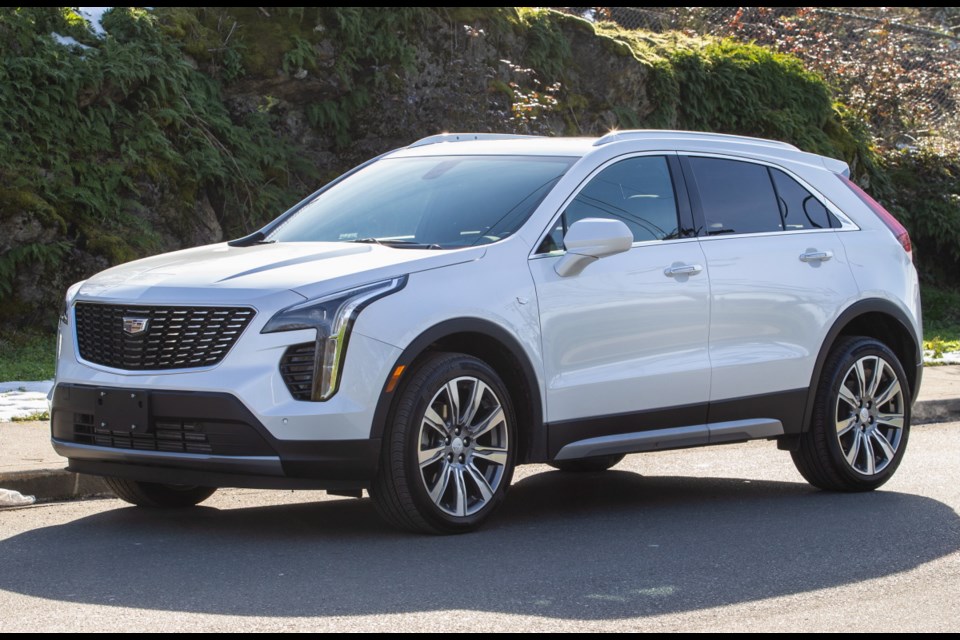Cadillac, a brand synonymous with luxury, is sending a shudder down the spine of the non-luxury segment by pricing its new XT4 compact crossover/SUV for as little as $34,400.
The non-luxury compact SUV segment is red-hot right now, with offerings from every manufacturer. The luxury segment has been well represented over the years, except for Cadillac — until now.
While the XT4 is late to the dinner table, Cadillac has chosen to make a grand entrance while everybody is assembled.
Being tardy has meant Cadillac has had the time to figure out what has worked — and what hasn’t — for the competition.
By coming in with a low price, Cadillac certainly has everybody’s attention, especially manufacturers that have been offering more and more luxurious models.
The XT4 is currently the least-expensive Cadillac you can buy.
There are three trim levels. The Luxury model (the base) has only the bare essentials and only front-wheel drive (almost everybody wants all the bells and whistles and all-wheel drive), but it is eye-opening nevertheless.
I drove the next model up, a Premium Luxury with all-wheel drive, with a list price of $42,795. The XT4 is also available in a Sport trim, which replaces some of the Premium Luxury features, with no change in price.
The last trim looks as if it is aimed at current drivers of European luxury brands, which have a more sporty bent to their personalities.
The XT4 is the smallest SUV Cadillac makes. It has an XT5 and soon an XT6 if you need more room for passengers and cargo.
At 4,599 millimetres in length, it is 47 mm longer than the Lincoln MKC, but 117 mm shorter than the BMW X3.
The interior is spacious, generous for the front occupants and comfortable for the rear. With the back seats up, there is 637 litres of cargo capacity in the back, which is more than the X3. With the seats down, you can carry 1,385 litres of cargo.
If you are are expecting an opulent interior from days gone by, you will be disappointed. Instead, you will be presented with a contemporary-styled interior comparable to the best European and Japanese luxury vehicles — to a point.
To keep costs down, Cadillac, like many manufacturers, uses hard plastics in areas where a person is unlikely to interact or touch, such as the lower dash and door. So you get the premium, stitched, soft-padded materials where you would most likely see, touch or feel.
The cabin has a businesslike feel to it, with crisp displays and an eight-inch infotainment screen at its centre. You can interact with it by touch or via a knob mounted on the centre console. Apple AirPlay, Android Auto and Wi-Fi hotspot are standard, and GPS-based navigation optional.
Unlike most of the competition, Cadillac for some reason chose not to put a USB plug in the centre armrest (where a phone cradle is positioned). This means that you have to run a cable from the front of the dash (the nearest USB plug) and along the transmission to hook up and charge your phone. A wireless smartphone charging pad is optional.
There is only one powertrain — a turbocharged 2.0-litre four-cylinder mated to a nine-speed automatic transmission. The engine produces 237 horsepower and 258 pound-feet of torque.
The engine, using GM’s Active Fuel Management system, features cylinder deactivation that deactivates two of the engine’s four cylinders under light load. It’s hard to imagine cruising along the highway — in a Cadillac, no less — on two cylinders.
Cadillac boasts a 10.9 litre per 100 km fuel consumption in the city and 8.2 on the highway.
Acceleration is sprightly, taking about eight seconds to accelerate to 100 km/h. It merged well onto the highway and was commendably quiet when cruising.
Despite its European aspirations, the XT4 isn’t as entertaining to take on back roads. It’s steering just isn’t as precise as a BMW, which is the benchmark for this segment.
Cadillac offers a whole plethora of pedestrian safety and collision reducing technology, but most of them are optional.
Lane-change and blind-zone alert is standard equipment, but lane-departure and lane-keep assist is not. Likewise, if you want forward collision alert, automatic braking, front pedestrian braking and low-speed automatic braking, they are options — sometimes bundled with other options.
Cadillac offers a better warranty than the non-luxury brands — four years and 80,000 km for the base warranty, and six years, 110,000 km on the powertrain.
Cadillac might be late to the party, but it may turn out to be the life of the party with the XT4.
THE SPEC SHEET
Type: Luxury compact SUV, front engine, all-wheel-drive
Engine: Turbocharged direct injection 2.0-litre four-cylinder, 237 hp at 5,000 r.p.m., 258 lb.-ft. of torque at 1,500 to 4,000 r.p.m.
Transmission: Nine-speed automatic
Dimensions (mm): Length, 4,599; width, 1,606; height, 1,627; wheelbase, 2,779
Curb weight (kg): 1,767
Price (base/as tested): $42,795/ $44,995 (includes $2,100 freight and PDI and $100 AC tax)
Options: Nil
Tires: 235/60 R 18 on alloy wheels
Fuel type: Premium
Fuel economy (L/100km): 10.9 highway 8.2 city
Warranty: Four years/80,000 km new car, six years/110,000 km powertrain and roadside assistance



